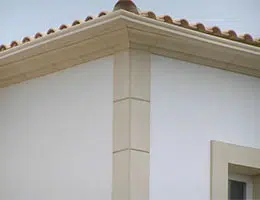 The Occitan word cornís , which derives from the Greek korōnís , came to our language as cornisa . The term refers to the set of moldings that act as the finishing touch of a certain construction. The notion also refers to the upper sector of the entablature.
The Occitan word cornís , which derives from the Greek korōnís , came to our language as cornisa . The term refers to the set of moldings that act as the finishing touch of a certain construction. The notion also refers to the upper sector of the entablature.
For example: “The criminal climbed a tree, then walked along the ledge of the building and finally broke the glass of a window to enter the apartment he robbed,” “The man remained on the ledge for an hour, threatening to jump into the void.” , “Part of the cornice of the Congress Palace fell off.”
The cornice protrudes from the façade , preventing rainwater from reaching the walls directly. Beyond this practical use, the cornice is also a decorative element that can present various shapes and figures.
There are examples of the use of the cornice from classical architecture , which is associated with that of Greece, although some historians of the subject use this concept to refer to some styles that have derived from it, either directly or indirectly. Broadly speaking, we can say that classical architecture exists: from Ancient Greece ; hellenistic ; of Ancient Rome .
In some constructions belonging to these periods, the cornice can be seen as one of the three elements of the entablature , a group of pieces that are in orbit above the columns, with the frieze and the architrave being the other two.
Here we find cornices that are made up of various moldings and are divided into two types: denticulated (it has denticles or modillions as decoration); chincha (used to visually divide the building into several floors). In some cases, the cornice of classical architecture was used to top the pediment of some temples (the curved or triangular top of the façade).
 It is worth mentioning that the ledge and suicide are two concepts that are often closely linked, especially in cities. Although cases do not always end in the completion of suicide, it is common for people to use the ledge to try to take their own life since it is a method that does not require the acquisition of a weapon or drugs, and is less violent than some of the alternatives. .
It is worth mentioning that the ledge and suicide are two concepts that are often closely linked, especially in cities. Although cases do not always end in the completion of suicide, it is common for people to use the ledge to try to take their own life since it is a method that does not require the acquisition of a weapon or drugs, and is less violent than some of the alternatives. .
The desire to commit suicide reflects one of the worst states a human being can reach , one from which it is very difficult to return, both due to emotional exhaustion and the feeling that "no one cares." We all want to grow up in a family that cares about us, that protects us and takes care of us, but life is very complex and the support of our loved ones is not always enough. The presence of the cornice as an almost fundamental part of the design of cities is a dangerous temptation for those who find themselves with very low defenses, and that is why it is appropriate to secure the buildings and hire surveillance services.
The concept, on the other hand, is used to name what takes place on the edge of a cliff or precipice : “To get to the hotel you have to cross a cornice path” , “Be careful if you are going to go to Santa María: the cornice road is very dangerous at this time of year because of the snowfall,” “When we managed to reach the top of the mountain, I took some beautiful photos from the cornice.”
“La cornisa” , finally, is the name of a famous journalistic program that is broadcast on Argentine television. Created by journalist Luis Majul , its first broadcast took place in 2000 on Channel 7 and then moved to América TV . Interviews and special reports are the main points of interest of “The cornice” .
